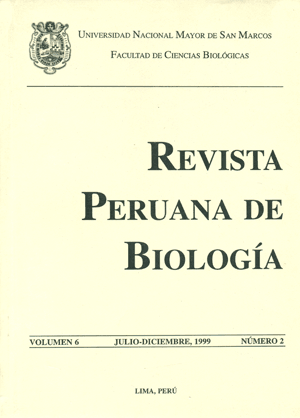Percolation technique of walker to evaluate Plasmodium vivax Grassi and Plasmodium malariae Laveran in Ashaninkas communities from Satipo (Junín, Peru)
DOI:
https://doi.org/10.15381/rpb.v6i2.8312Keywords:
Malarie, Plasmodium, parasitological diagnosis, native communities.Abstract
The precoloration technique of Walker was assayed in comparation with the classic Giemsa technique as a differential method to Plasmodium vivax and Plasmodium malariae, in 208 blood samples of seven Ashaninka communities from Rio Tambo district, Satipo, Junin, Peru. Density of parasites by crossing system (+) and by parasites/mL were higher with precoloration of Walker. The prevalence of the parasites was to P. vivax (24,52%) and P. malariae (0,48%) of all samples assayed. Of the seven communities evaluated from Rio Tambo district: Puerto Ocopa, Unión Puerto Ashaninka and Shimavenzo communities showed the highest prevalence of infection with 42,42%, 27,27% y 27,27% respectively. The ages between 0 to 10 and 41-50 years showed the highest prevalence of infection with 31,30% and 40% respectively. The prevalence of infection was independent with the sex. Density of parasites/mL with both techniques were higher in Puerto Prado community; but statistically independent with age and sex. The advantage of precoloration technique of Walker was investigated and some factors that would influence variations in the prevalence of infection and density of parasites of plasmodia assayed dependent on what communities were sampled, age and sex.Downloads
Downloads
Published
Issue
Section
License
Copyright (c) 1999 José A. Iannacone O., Cecilia Caballero R., José A. Rentería

This work is licensed under a Creative Commons Attribution-NonCommercial-ShareAlike 4.0 International License.
AUTHORS RETAIN THEIR RIGHTS:
a. Authors retain their trade mark rights and patent, and also on any process or procedure described in the article.
b. Authors retain their right to share, copy, distribute, perform and publicly communicate their article (eg, to place their article in an institutional repository or publish it in a book), with an acknowledgment of its initial publication in the Revista Peruana de Biologia.
c. Authors retain theirs right to make a subsequent publication of their work, to use the article or any part thereof (eg a compilation of his papers, lecture notes, thesis, or a book), always indicating its initial publication in the Revista Peruana de Biologia (the originator of the work, journal, volume, number and date).






